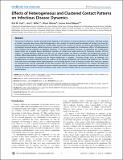| dc.contributor.author | Volz, Erik M. | |
| dc.contributor.author | Miller, Joel C. | |
| dc.contributor.author | Galvani, Alison | |
| dc.contributor.author | Ancel Meyers, Lauren | |
| dc.date.accessioned | 2012-06-05T00:14:23Z | |
| dc.date.issued | 2011 | |
| dc.identifier.citation | Volz, Erik M., Joel C. Miller, Alison Galvani, and Lauren Ancel Meyers. 2011. Effects of heterogeneous and clustered contact patterns on infectious disease dynamics. PLoS Computational Biology 7(6): e1002042. | en_US |
| dc.identifier.issn | 1553-734X | en_US |
| dc.identifier.issn | 1553-7358 | en_US |
| dc.identifier.uri | http://nrs.harvard.edu/urn-3:HUL.InstRepos:8830766 | |
| dc.description.abstract | The spread of infectious diseases fundamentally depends on the pattern of contacts between individuals. Although studies of contact networks have shown that heterogeneity in the number of contacts and the duration of contacts can have far-reaching epidemiological consequences, models often assume that contacts are chosen at random and thereby ignore the sociological, temporal and/or spatial clustering of contacts. Here we investigate the simultaneous effects of heterogeneous and clustered contact patterns on epidemic dynamics. To model population structure, we generalize the configuration model which has a tunable degree distribution (number of contacts per node) and level of clustering (number of three cliques). To model epidemic dynamics for this class of random graph, we derive a tractable, low-dimensional system of ordinary differential equations that accounts for the effects of network structure on the course of the epidemic. We find that the interaction between clustering and the degree distribution is complex. Clustering always slows an epidemic, but simultaneously increasing clustering and the variance of the degree distribution can increase final epidemic size. We also show that bond percolation-based approximations can be highly biased if one incorrectly assumes that infectious periods are homogeneous, and the magnitude of this bias increases with the amount of clustering in the network. We apply this approach to model the high clustering of contacts within households, using contact parameters estimated from survey data of social interactions, and we identify conditions under which network models that do not account for household structure will be biased. | en_US |
| dc.language.iso | en_US | en_US |
| dc.publisher | Public Library of Science | en_US |
| dc.relation.isversionof | doi:10.1371/journal.pcbi.1002042 | en_US |
| dc.relation.hasversion | http://www.ncbi.nlm.nih.gov/pmc/articles/PMC3107246 | en_US |
| dash.license | LAA | |
| dc.title | Effects of Heterogeneous and Clustered Contact Patterns on Infectious Disease Dynamics | en_US |
| dc.type | Journal Article | en_US |
| dc.description.version | Version of Record | en_US |
| dc.relation.journal | PLoS Computational Biology | en_US |
| dash.depositing.author | Miller, Joel C. | |
| dc.date.available | 2012-06-05T00:14:23Z | |
| dash.affiliation.other | SPH^Epidemiology | en_US |
| dc.identifier.doi | 10.1371/journal.pcbi.1002042 | * |
| dash.contributor.affiliated | Miller, Joel C. | |


